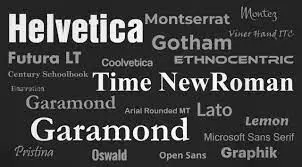The Timeless Elegance of Serif Style Fonts: A Closer Look at Their Enduring Appeal

In the world of typography, few styles carry the same timeless elegance and sophistication as serif fonts. With their distinctive serifs – those small decorative strokes or tails attached to the ends of letters – serif style fonts have been a staple of design for centuries, gracing everything from books and newspapers to branding and signage. In this blog post, we'll delve into the allure of serif style fonts, their unique characteristics, and why they continue to captivate designers and readers alike.
1. A Brief History of Serif Style Fonts: The origins of serif style font can be traced back to ancient Rome, where stone carvers would chisel serifs onto letters to aid in their readability. Over time, these serifs evolved into distinctive stylistic elements, giving rise to the serif style we know today. In the 15th century, with the advent of movable type and the printing press, serif style fonts became ubiquitous in printed materials, thanks to their legibility and aesthetic appeal. Since then, serif style fonts have continued to evolve, with different variations emerging to suit various design trends and preferences.
2. Characteristics of Serif Style Fonts: Serif style fonts are characterized by the presence of serifs – those small strokes or tails that extend from the ends of letters. These serifs serve both functional and decorative purposes, aiding in letter recognition and guiding the reader's eye along the text. Serif style fonts are further divided into categories such as Old Style, Transitional, and Modern, each with its unique characteristics and historical influences. Old Style serifs, for example, are characterized by their organic, calligraphic forms, while Modern serifs feature more geometric and stylized letterforms.
3. Enduring Appeal and Timeless Elegance: Despite the proliferation of digital media and the rise of minimalist design trends, serif style fonts continue to enjoy enduring popularity and widespread use. Their timeless elegance and classic aesthetic make them well-suited to a variety of design applications, from print to digital and everything in between. Serif style fonts evoke a sense of tradition, sophistication, and authority, making them a popular choice for books, magazines, newspapers, and other editorial content. Their versatility also extends to branding and identity design, where they can convey a sense of heritage and reliability.
4. Enhancing Readability and Legibility: One of the key benefits of serif style fonts is their enhanced readability and legibility, particularly in long-form text. The serifs act as visual cues that help guide the reader's eye along the text, making it easier to navigate and comprehend. Studies have shown that serif style fonts are generally more readable than sans serif fonts, especially in printed materials, where the added detail of the serifs aids in letter recognition. As a result, serif style fonts are often preferred for body text in books, articles, and other long-form content.
5. Creating Visual Hierarchy and Emphasis: Serif style fonts are also effective for creating visual hierarchy and emphasis in design projects. The contrast between the thick and thin strokes, as well as the presence of serifs, helps draw attention to key elements of the text, such as headlines, subheadings, and pull quotes. By pairing serif style fonts with complementary typefaces, designers can create dynamic and visually engaging layouts that capture the audience's attention and convey the intended message effectively.
6. Pairing Serif Style Fonts with Other Typefaces: While serif style fonts excel at conveying tradition and sophistication, they can also benefit from pairing with other typefaces to create contrast and visual interest in design projects. Pairing serif style fonts with sans serif fonts, for example, can create a contemporary and balanced look that combines the best of both worlds. Similarly, pairing serif style fonts with script or display fonts can add a touch of personality and flair to the design, creating a dynamic typographic composition.
In conclusion, serif style fonts are a timeless and versatile choice for designers seeking to convey tradition, sophistication, and elegance in their projects. With their distinctive serifs, enhanced readability, and classic aesthetic, serif style fonts continue to captivate audiences and leave a lasting impression in print and digital media alike. Whether used for body text in books and magazines or for branding and identity design, serif style fonts offer a level of timeless elegance and sophistication that is unmatched by other type styles.














